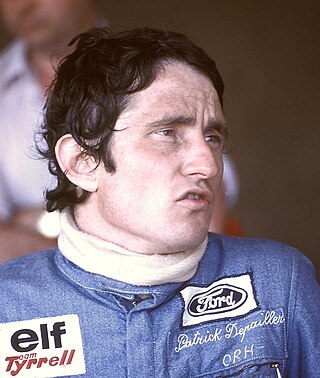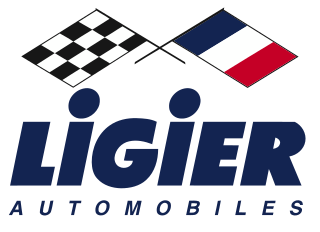
René Alexandre Arnoux is a French former racing driver who competed in 12 Formula One seasons. He participated in 165 World Championship Grands Prix winning seven of them, achieving 22 podium finishes and scoring 181 career points. His best finish in the World Drivers' Championship was third in 1983 for Ferrari. In 1977, Arnoux won the European Formula Two Championship. In 2006 he raced in the inaugural season of the Grand Prix Masters series for retired F1 drivers.

The 1977 Swedish Grand Prix was a Formula One motor race held at the Scandinavian Raceway on 19 June 1977. It was the eighth race of the 1977 Formula One season.

The 1979 Formula One season was the 33rd season of FIA Formula One motor racing. It featured the 1979 World Championship of F1 Drivers and the 1979 International Cup for F1 Constructors which were contested concurrently over a fifteen-round series which commenced on 21 January 1979, and ended on 7 October. The season also included three non-championship Formula One races. Jody Scheckter of Scuderia Ferrari won the 1979 World Championship of F1 Drivers while Scuderia Ferrari won 1979 International Cup for F1 Constructors. Gilles Villeneuve made it a 1–2 for Ferrari in the championship, concluding a successful second half of the 1970s for Ferrari. Alan Jones finished the season strongly for Williams, finishing third in the championship and with teammate Clay Regazzoni scoring Williams's first ever Grand Prix win as a constructor. Scheckter's title was Ferrari's last drivers' title for 21 years, before Michael Schumacher won five consecutive titles for the team between 2000 and 2004.

Patrick André Eugène Joseph Depailler was a racing driver from France. He participated in 95 World Championship Formula One Grands Prix, debuting on 2 July 1972. He also participated in several non-championship Formula One races.

Jean-Pierre Maurice Georges Beltoise was a French Grand Prix motorcycle road racer and Formula One driver who raced for the Matra and BRM teams. He competed in 88 Grands Prix achieving a single victory, at the 1972 Monaco Grand Prix, and a total of eight podium finishes.
The Ligier JS27 was the Formula One car used by French team Ligier to compete in the 1986 season.

Équipe Ligier is a motorsport team, best known for its Formula One team that operated from 1976 to 1996. The team was founded in 1968 by former French rugby union player Guy Ligier as a sports car manufacturer.

The Ligier JS5 was the first Formula One racing car made by Ligier. Designed by Gérard Ducarouge, it competed in the 1976 Formula One season, gaining 20 points and getting sixth place overall in the Constructor's Championship. The car also gave its driver Jacques Laffite and Ligier their first ever pole position at the 1976 Italian Grand Prix at Monza.
The Ligier JS7 was the second Formula One racing car made by Ligier. As with the preceding JS5, the letters "JS" were in tribute to Guy Ligier's friend Jo Schlesser who was killed in the 1968 French Grand Prix.

There have been 74 Formula One drivers from France, the most successful of them being Alain Prost, who won the World Drivers' Championship four times.

The Shadow DN7 was a Formula One car used by the Shadow team in two races late in the 1975 Formula One season. Driven by Jean-Pierre Jarier, it never finished a race.
The Ligier JS37 was a Formula One car designed by Frank Dernie and Gérard Ducarouge and built by the Ligier team for the 1992 Formula One season. The car was powered by the Renault RS3 V10 engine and ran on Goodyear tyres.

The Ligier JS33 was a Formula One car used by the Ligier team during the 1989 Formula One season. Its best finish in a race was fifth, at the 1989 Canadian Grand Prix. The JS33 was updated to a 'B' spec for use in the following season, but failed to score any points for the team.

The Matra Company's racing team, under the names of Matra Sports, Equipe Matra Elf and Equipe Matra Sports, was formed in 1965 and based at Champagne-sur-Seine (1965–1967), Romorantin-Lanthenay (1967–1969) and Vélizy-Villacoublay (1969–1979). In 1979 the team was taken over by Peugeot and renamed as Automobiles Talbot.
The Ligier JS21 was a Formula One racing car manufactured and raced by Ligier during the 1983 Formula One season. Powered by a Cosworth V8 engine while the majority of teams used turbo power, the team failed to score any points.

The Tyrrell 008 was a Formula One car manufactured and raced by the Tyrrell Racing Organisation team during the 1978 season. Driven by Didier Pironi and Patrick Depailler, it achieved several podium finishes including a win at the 1978 Monaco Grand Prix.

The Ligier JS19 was a Formula One racing car manufactured and raced by Équipe Ligier during the 1982 Formula One season. Powered by a Talbot-badged Matra V12 engine, the JS19 was driven by Jacques Laffite and Eddie Cheever.

The Minardi M185 was a Formula One car, designed for Minardi by Giacomo Caliri for use in the 1985 season. For the following season, it was updated to a M185B specification. It was an unreliable car and only finished three races and did not score any points for the team.

The Williams FW04 was a Formula One car used by Frank Williams Racing Cars during the 1975 season and Wolf–Williams Racing during the 1976 season. The car was a development of the Williams FW and two were built. Although not a particularly successful car, an FW04 finished second at the 1975 German Grand Prix.

The Ligier JS17 was a Formula One car designed by Gérard Ducarouge and Michel Beaujon for use by the Ligier team during the 1981 season. Powered by a Talbot-badged Matra V12, the JS17 was driven to two Grand Prix wins by Jacques Laffite. It was updated to JS17B specification for the 1982 season until it was replaced later that year by the JS19.















